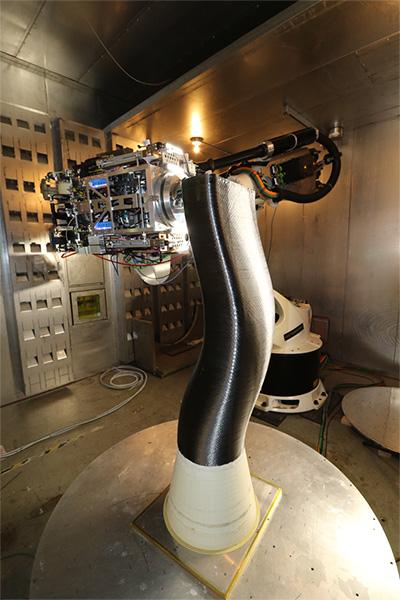- FMA
- The Fabricator
- FABTECH
- Canadian Metalworking
Our Publications
Categories
- Additive Manufacturing
- Aluminum Welding
- Arc Welding
- Assembly and Joining
- Automation and Robotics
- Bending and Forming
- Consumables
- Cutting and Weld Prep
- Electric Vehicles
- En Español
- Finishing
- Hydroforming
- Laser Cutting
- Laser Welding
- Machining
- Manufacturing Software
- Materials Handling
- Metals/Materials
- Oxyfuel Cutting
- Plasma Cutting
- Power Tools
- Punching and Other Holemaking
- Roll Forming
- Safety
- Sawing
- Shearing
- Shop Management
- Testing and Measuring
- Tube and Pipe Fabrication
- Tube and Pipe Production
- Waterjet Cutting
Industry Directory
Webcasts
Podcasts
FAB 40
Advertise
Subscribe
Account Login
Search
Electroimpact offers 6-axis printer that combines AFP and FFF technologies
- October 21, 2020
- Product Release
- Additive Manufacturing
Factory automation and tooling solutions provider Electroimpact Inc. has combined two processes—automated fiber placement (AFP) and fused filament fabrication (FFF) 3D printing—into a unified system called Scalable Composite Robotic Additive Manufacturing. The 6-axis SCRAM reportedly allows tool-free fabrication of aerospace-grade structures from continuous-fiber-reinforced (CFR) composites.
According to Electroimpact, most 3D printing processes are actually “2.5D” printing, as material is deposited in flat slices stacked together to form a 3D object. With SCRAM, on the other hand, layers of CFR thermoplastic can take the shape of complex contours, such as aerodynamic surfaces and ducts for fluid flow.
“Furthermore,” reports the manufacturer, “as [SCRAM] is a 6-axis process, fiber orientation within each layer can be tailored to the specific application to provide optimal strength and stiffness distribution throughout the part, much like a conventional AFP system.”
Conventional automated fiber layup always requires a substantial investment in hard tooling that is inflexible, expensive, and has a long lead time, says Electroimpact. Conversely, operators of a SCRAM cell can simply print a support tool on demand, starting from just a flat plate. Later, after the part has finished printing, the tool material is dissolved away. This enables rapid design iteration and designing part geometries such as internal channels that are difficult or impossible to produce otherwise.
In addition to the CFR and FFF printing processes, SCRAM cells also are fitted with an FFF nozzle optimized for deposition of thermoplastic material reinforced with short or “chopped” fiber. Among the materials the system prints are PEKK and PEEK; nylons; water-solubles; and carbon-, glass-, and boron-fiber.
- Podcasting
- Podcast:
- The Fabricator Podcast
- Published:
- 04/16/2024
- Running Time:
- 63:29
In this episode of The Fabricator Podcast, Caleb Chamberlain, co-founder and CEO of OSH Cut, discusses his company’s...
- Trending Articles
- Industry Events
16th Annual Safety Conference
- April 30 - May 1, 2024
- Elgin,
Pipe and Tube Conference
- May 21 - 22, 2024
- Omaha, NE
World-Class Roll Forming Workshop
- June 5 - 6, 2024
- Louisville, KY
Advanced Laser Application Workshop
- June 25 - 27, 2024
- Novi, MI

























